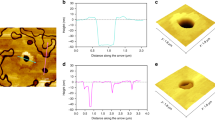Abstract
Compounds of transition metals from Groups IV and V with carbon, nitrogen, or boron (e.g., NbC, TiN, and ZrB2) are electronically conductive but are also very hard and have high melting points. These materials resist electromigration and prevent diffusion because their strong interatomic bonding makes the activation energy for diffusion very high. Carbides and nitrides form the NaCl crystal structure, but are nonstoichiometric with nonmetal atom vacancies that scatter electrons. This defect-controlled resistivity can be eliminated with an order-disorder transformation at a specific nonmetal/metal ratio. The diborides are essentially sentially stoichiometric and have low resistivities. These metallic ceramics can be deposited as thin films to form interconnects and diffusion barriers in ultralarge-scale integrated circuits.
Similar content being viewed by others
References
P. Schwartzkopf and R. Kieffer,Refractory Hard Metals (New York: Macmillan Publishing Co., 1953).
G.V. Samsonov,Refractory Transition Metal Compounds (New York: Academic Press, 1964).
E.K. Storm,The Refractory Carbides (New York: Academic Press, 1967).
W.S. Williams,Progress in Solid State Chemistry 6, ed. H. Reiss and J.O. McCaldin (New York: Pergamon Press, 1971), pp. 57–118.
L.E. Toth,Transition-Metal Carbides and Nitrides (New York: Academic Press, 1971).
K. Schwarz,CRC Critical Reviews in Solid State and Materials Sciences, 13 (1987), pp. 221–257.
R. Freer, ed.,The Physics and Chemistry of Carbides, Nitrides, and Borides NATO ASI Series E, vol. 185 (Dordrect: Kluwer Academic Publishers, 1990).
A.I. Gusev,Phys. Stat. Sol. B, 163 (1991), pp. 17–54.
V.A. Gubanov, A.L. Ivanovsky, and V.P. Zhokov,Electronic Structure of Refractory Carbides and Nitrides (Cambridge University Press, 1994).
F.W. Clinard, Jr., and C.P. Kempter,J. Less-Common Metals 15, 59 (1968).
L. Hollander, Jr.,J. Appl. Phys., 32, 996 (1961).
J. Piper,Nuclear Metallurgy Symp., 10 (New York: Met. Soc. of AIME, 1962).
W.S. Williams,Phys. Rev., 135, (A505) (1962).
J.-F. Lei, H. Okimna, and J.O. Brittain,Mat. Sci. And Eng., A123, (1990), pp. 129–140.
J.R. Cooper and RL. Hansler,J. Chem. Phys., 39 (1963), p. 248.
G. Santoro and R.T. Dolloff,J. Appl. Phys., 39 (1968), p. 2293.
W.S. Williams,Materials Research Society Symposium Proceedings, 411—Electrically Based Microstructural Characterization, ed. R.A. Gerhardt, S.R. Taylor, and E.J. Garboczi (Pittsburgh, PA, MRS, 1996), pp. 169–176.
J. Venables, P. Kahn, and R. Lye,Phil. Mag., 18 (1968), p. 177.
C. de Novion, P. Lorenzelli and P. Costa,Compt. Rend., 263 (1966), p. 775.
L.W. Shacklette and W.S. Williams,J. Appl. Phys., 42 (1971), pp. 4698–4703.
L.W. Shacklette and W.S. Williams,Phys. Rev., B7 (1973), pp. 5041–5053.
L.C. Dy and W.S. Williams,J. Appl. Phys., 53 (1982), pp. 8915–8927.
G.H. Emmons and W.S. Williams,J. Mat. Sci., 18 (1983), pp. 2589–2602.
V.S. Nesphor et al.,Inorganic Materials, 2 (1966), p. 865.
F.A. Modine et al.,Phys. Rev., B40 (1989), pp. 9558–9564.
B. Chakraborty and P.B. Allen,Phys. Rev. Lett., 42 (1979), pp. 736–738.
L.W. Shacklette, L.G. Radosevich, and W.S. Williams,Phys. Rev., B4 (1971), p. 84.
M. Tsuchida et al.,Jpn. J. Appl. Phys., 32 (1993), pp. 1227–1228.
J.E. Sundgren,Thin Solid Films, 128 (1985), pp. 21–44.
C. Goldberg et al.,Conf: Proc. of ULSI Symposium 1995, (Pittsburgh, PA: MRS, 1996), pp. 247–257.
N. Yokoyama, K. Hinode, and Y. Homma,J. Electrochem. Soc., 138 (1991), pp. 190–195.
O.A. Gohkova et al.,Soviet Physics—Solid State, 7 (1966), p. 2317.
D. Kohlstedt and W.S. Williams,Phys. Rev., B3 (1971), p. 293.
L.W. Shacklette and H.A. Ashworth,Phys. Rev., B12 (1975) pp. 1146–1153.
G.L. Pearson and J. Bardeen,Phys. Rev., 75 (1949), p. 865
V. Ern and A.C. Swittendrick,Phys. Rev., 137 (1965), p. 1927.
A. Necket et al.,J. Phys. C, 9 (1976), p. 579.
L. Ramqvist et al.,J. Phys. Chem. Solids., 30 (1969), p. 1835.
H.J. Juretschke and R. Steinitz,J. Phys. Chem. Solids, 4 (1958), pp. 118–127.
R.T. Dolloff and W.S. Williams,Bull. Am. Phys. Soc. Ser. II, 4 (1959).
R.K. Williams, R.S. Graves, and F.J. Weaver,J. Appl. Phys., 59 (1986), pp. 1552–1556.
M.V. Frandsen, Ph.D. thesis, University of Illinois at Urbana-Champaign (1997).
M. Rahman et al.,J Am. Ceram. Soc., 78 (1995), pp. 1380–1382.
H. Ihara,Researches of the Electrochemical Laboratory (Japan), 725 (1977).
Y. Ishizawa and T. Tanaka,Inst. Inst. Phys. Conf. Ser. No. 75, Ch. 1 (Adam Hilger Ltd, 1986), pp. 29–43.
C.S. Choi et al.,J. Appol. Phys., 69 (1991), pp. 7853–7861.
K. Bachman and W.S. Williams,J. Appl. Phys., 42 (1971), pp. 4407–4407.
S. Sarian,J. Appl. Phys., 39 (1968), p. 3305.
S. Sarian,J. Appl. Phys., 40 (1969), p. 3515.
J.W. Morris, Jr., C.-U. Kim, and S.H. Kang,JOM, 48 (4) (1996), pp. 43–46.
C. Emsberger et al.,J. Vac. Sci. Technol., A4 (1986), pp. 2784–2788.
E.J. Cukauskas and W.L. Carter,IEEE Trans. on Magnetics 25, #2 (1989), pp. 1235–1238.
M. Aoyagi et al.,Jpn. J. Appl. Phys., 31 (1992), pp. 1778–1783.
P. Mochel, C. Allison, and W.S. Williams,J. Am. Ceram. Soc., 64 (1981), pp. 185–187.
Additional information
Wendell S. Williams earned his Ph.D. in physics at Cornell University in 1956. He was a research physicist with Union Carbide Corporation, a professor of physics and engineering at the University of Illinois, and department chair of materials science and engineering at Case Western Reserve University. Dr. Williams, now retired, is a member of TMS.
Rights and permissions
About this article
Cite this article
Williams, W.S. Transition metal carbides, nitrides, and borides for electronic applications. JOM 49, 38–42 (1997). https://doi.org/10.1007/BF02914655
Issue Date:
DOI: https://doi.org/10.1007/BF02914655




